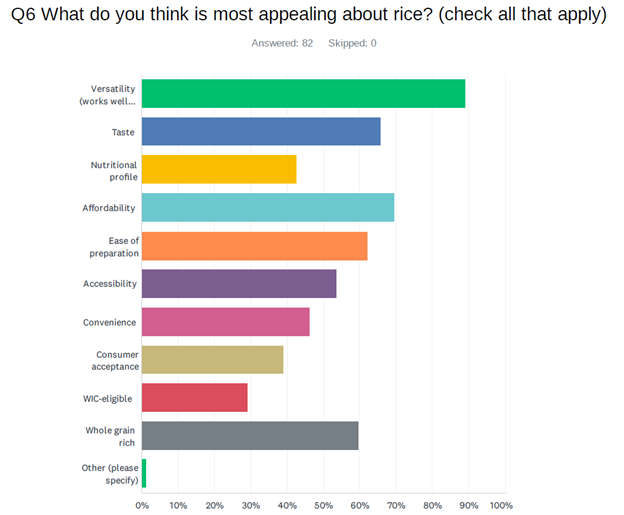 Seems like the correct answer is "all of the above"
Seems like the correct answer is "all of the above"
Nov 07, 2022
ARLINGTON, VA -- Last month, USA Rice exhibited at the Academy of Nutrition and Dietetics’ 2022 Food & Nutrition Conference & Expo (FNCE) in Orlando, Florida, to engage directly with nutrition professionals, answer rice-related questions, and distribute USA Rice resources that included domestic varietal information, nutrition handouts, patient one-pagers, rice research, sustainability materials, rice recipes, and food safety facts.
Nutrition professionals who visited the USA Rice booth participated in a survey on rice usage, applications, nutritional reputation, and the importance of product of origin claims. More than 80 attendees (about one in five booth visitors) who represented dietitians, food policymakers, healthcare providers, nutrition scientists, and other food industry leaders from across the country, completed the questionnaire that asked: “Do you use or recommend rice as part of a healthy diet?”; “What is the best use or application of rice?”; and,“Does using rice grown in the United States matter to you?”
“This survey is important because we hear directly from experts in the nutrition field across a range of different capacities on what they think about rice,” said Cameron Jacobs, USA Rice senior director of domestic promotion. “And I am happy to report, once again, that the results paint an overall positive picture for rice’s role and reputation, and provided some significant takeaways relevant to U.S.-grown rice when it comes to the nutrition landscape.”
An overwhelming majority of respondents (97.5%) use and recommend rice and rice products as a foundational component of a healthy diet and lifestyle because it’s a whole grain (75.61%), gluten-free (68.29%), a beneficial complex carbohydrate (56.1 percent), and a good source of energy (51.22%).
“Nearly 60% of survey respondents indicated country of origin is important to them which is why we encourage all of our members to use the Grown in the USA logo on their packaging,” said Jacobs. “Half of the survey respondents said that rice held a strong nutritional reputation, with an additional 20% adding they saw no change to rice’s reputation despite recent misinformed media reports and lingering anti-carbohydrate sentiments.”
The number one recommended variety by the nutrition professionals was whole grain brown rice at 89%, with 60% specifically recommending whole grain aromatics. Wild rice (58.54%) and aromatic white rice varieties (37.8%) rounded out the top three recommendations.
The top rice characteristics identified by survey respondents were versatility (89.02%), affordability (69.51%), taste (65.85%), and ease of preparation (62.2%), while confusion on carbohydrates, rice’s role within a diabetic diet, and a lack of understanding between white and brown rice were presented as barriers to use and acceptance.
When it came to using and recommending rice, only three respondents cited heavy metal concerns, while more than 81% indicated nothing prevented them from recommending rice as part of a healthy diet.